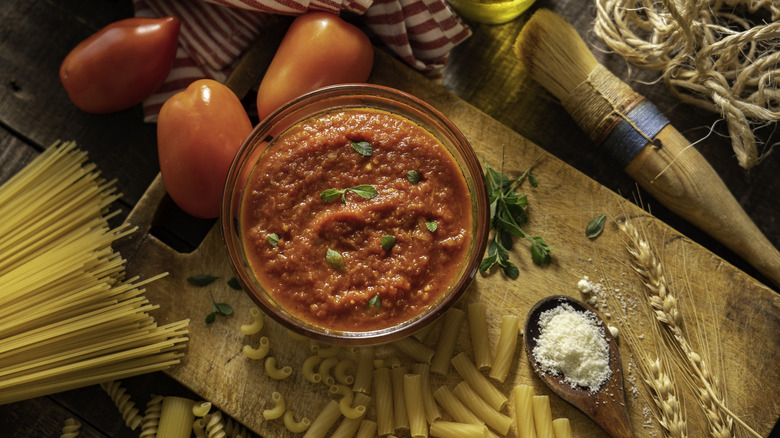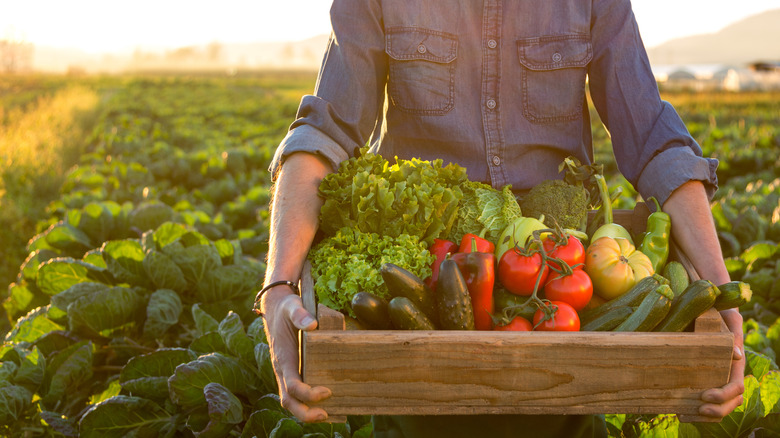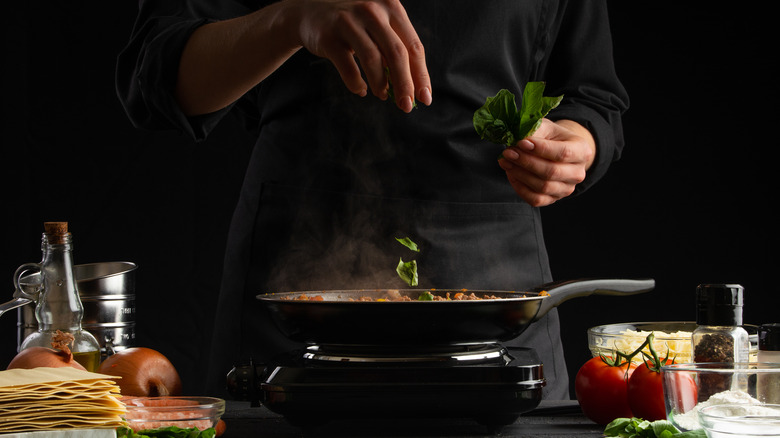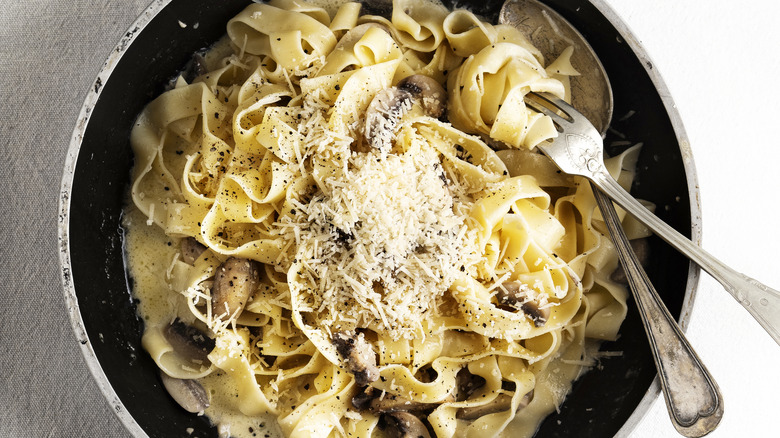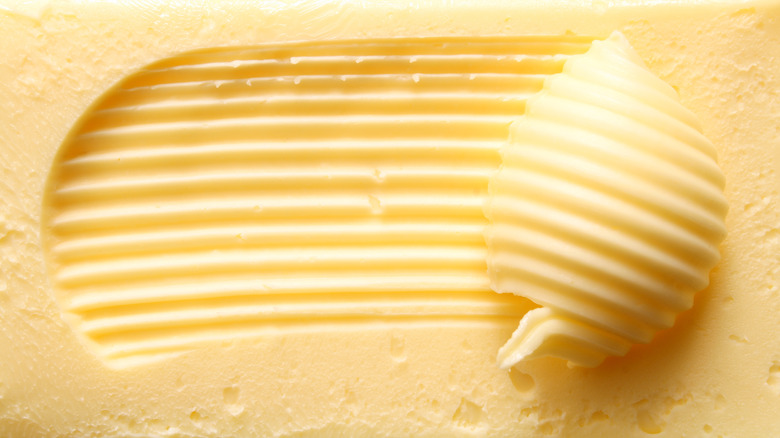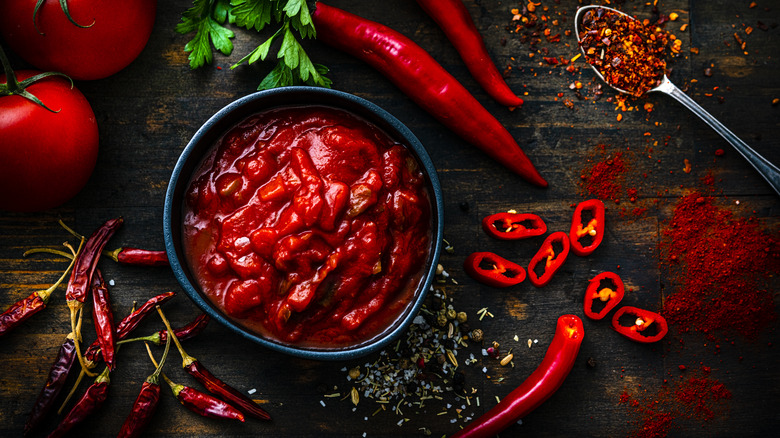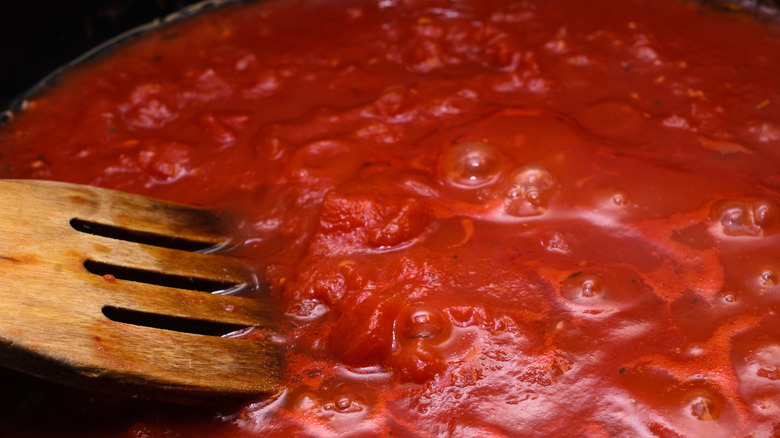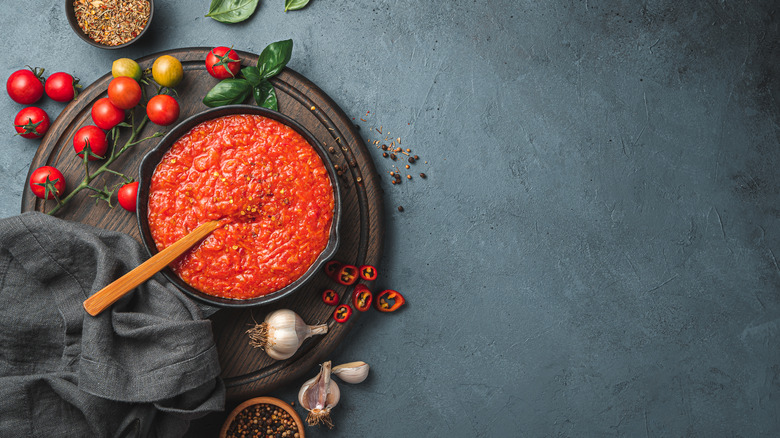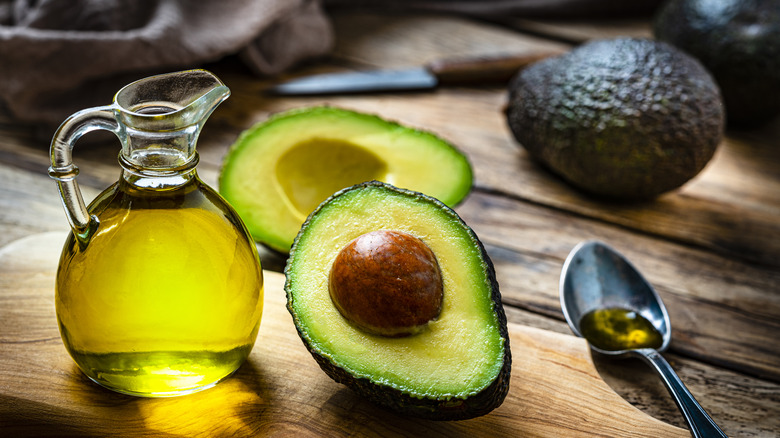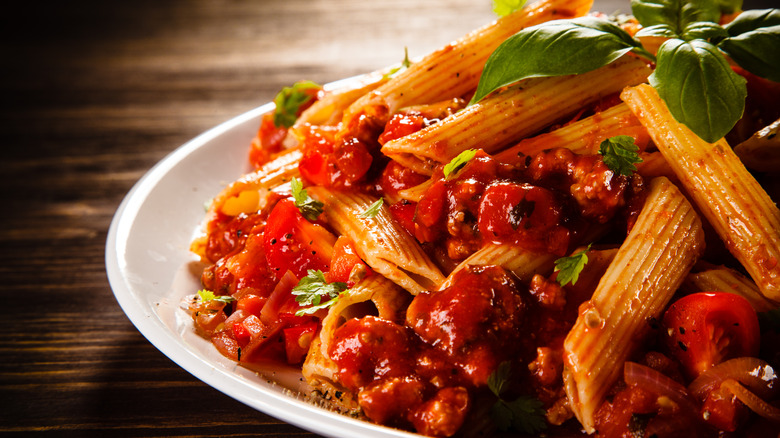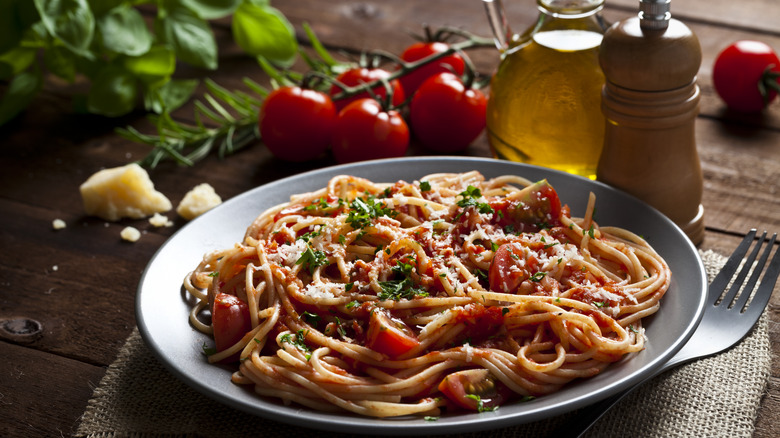The Extra Steps Restaurants Take To Make Pasta Sauce Taste Better
High-quality pasta sauce can taste good on almost anything. Sure, we usually toss it up with a steaming batch of spaghetti, but this savory delight can also add some jazz to dishes ranging from meatball subs to good old-fashioned garlic bread. The only problem? Not everybody has the time or skill to throw together a sauce that can compete with the restaurant down the street.
In fact, more often than not home cooks use pre-made sauces to inject flavor into their Italian fare, with two out of every three U.S. consumers reaching for jarred pasta sauce instead of making their own from scratch. Unfortunately, this can seriously downgrade the overall flavor of your dinner. As food expert George Mahe once wrote for St. Louis Magazine, jarred sauces are full of "taste-altering preservatives and stabilizers." These ingredients are selected to keep jarred fare good while it waits on the shelf, but they also compromise the flavor of what are oftentimes generations-old family recipes.
Next time you're getting ready to make pasta bolognese or cacio e pepe, consider leaving the pre-made fare in the cabinet. Instead, grab some fresh produce and some good seasoning, then taste the difference. Even if the whole cooking process seems like a lot to you, fear not! There are plenty of professional chefs who can provide you with all kinds of helpful tips and tricks to make a pasta dish that tastes like it was made at a real Italian restaurant.
Restaurants know that high-quality ingredients are key
Your pasta sauce is, at its simplest, a combination of all the ingredients that you put into it. That means that choosing high-quality vegetables, fruit, and herbs for your recipe can really make a difference. Selecting a big, juicy tomato for your marinara sauce can infuse your final product with a farm-fresh flavor, while going for something a little bit less ripe could result in an acidic aftertaste. A clove of garlic sourced from your local farmer's market might taste rich and pungent, while the one you found at the back of your cupboard could infuse some bitterness into your recipe.
Speaking to Mashed, Chef Nick Pallone of The Tailor's Son attested that restaurant sauce often tastes better than homemade alternatives, simply because they hire experts to choose which ingredients to buy and which to leave behind. "By and large the ingredients that are available to chefs are available to the general public. Knowing how to source them — or what to source, for that matter — is the problem."
So what exactly should home cooks buy? According to Pallone, colatura di alici is a great start. This Italian fish sauce is made with fermented anchovies, and it can seriously add oomph to your dish. To put this chef-approved advice to the test, invest in a bottle of colatura and blend a little into your homemade sauce to infuse your meal with deep umami tones.
Eateries alter their sauces as they cook
Using good ingredients when you cook is one thing, but knowing when to change things up is something else altogether. Luckily for most restaurants, they hire trained chefs who are skilled enough to understand when a recipe is going wrong — and to know how to fix it. As culinary expert George Mahe told St. Louis Magazine, "In a restaurant, chefs are constantly altering sauces as they tend to change complexions in a restaurant setting." In practice, this means that they are frequently adding new ingredients to the mix. Mahe revealed that some common "last-minute additions" might include, "a little more water, some milk, maybe a jolt of fresh herbs, fresh grated cheese, fresh seafood, etc."
Of course, it's important to note that these culinary professionals don't change their pasta sauces based on what they see, but rather on what they taste. In a Quora response that was later published in Slate, former chef Jonas Mikka Luster revealed that he would frequently sample his cooking to make sure that it was up to par. "Chefs learn very quickly to mentally assemble a flavor profile from tasting ingredients. For example, I taste my pasta water every once in a while. I taste the sauce. I ask someone to fry me up a small piece of something and see if the seasoning worked." All in all, Luster said, this taste-testing process is what helped him know "if we're on the right track."
Restaurants know that cheesier is oftentimes better
Plenty of amateur cooks are aware of the power of good Italian cheeses. It's easy to sprinkle a handful of beautifully aged Parmesan or Bel Paese over the top of your pasta dish before serving, and many pasta enthusiasts embrace this practice as a way to improve both the flavor and the presentation of their home-cooked fare. The only problem? They don't always add this ingredient into the pasta sauce itself.
According to chef Zachary Lanier of Double Zero, stirring some delicious cheese into your pasta sauce can seriously take it up a notch. In an interview with Insider, Lanier hinted that this move is common practice at plenty of restaurants, mentioning, "One of my favorite enhancements is the addition of ricotta cheese, which I fold into the sauce as I'm heating it up. In a minute or two, you have a creamy pink, delicious sauce that will take your favorite pasta to the next level." Yum!
Apparently, though, this strategy doesn't work well for every single type of sauce out there. Bolognese sauce, for example, tends to focus on simple meaty flavors, as opposed to the creamy goodness of cheese. With this in mind, Lanier advises to think twice about things like flavor profile before mindlessly dumping a bag of mozzarella into your pan. "Adding cream or dairy takes the sauce in a whole other direction." That said, he also notes that it's "perfect" for cacciatore.
Italian establishments often leave the butter behind
It's no secret that many restaurants rely on butter to inject a bit of flavor into their dishes. Anthony Bourdain once told Oprah Winfrey that French restaurants use so much of it that diners will walk out having consumed "a stick plus." Meanwhile, one all-American chain, Ruth's Chris Steak House, has long boasted that it melts some butter on its steaks before serving. It would be easy to assume that you should top your finished sauce with a big ol' dollop of it to give it one last dose of flavor. Chefs say: Not so fast.
While many restaurants do use plentiful butter in their dishes, most Italian eateries tend to use more olive oil. This is especially true at the end of the cooking process when the pasta and the sauce are cooking in the same pot. At this point, chefs add a nice drizzling of extra virgin olive oil over their sauces for a process that Italians refer to as mantecare, meaning to mix a sauce until it's rich and creamy.
So why don't they use butter? Well, according to Maialino's Jason Pfifer, the ingredient might have a little too much flavor to make it a good addition to your sauce. Speaking with Epicurious, he explained, "Butter can be so rich and overpowering." He also noted that many chefs can lean on it a little too heavily in their cooking, saying how it can be "a bit of a crutch."
They aren't shy about sugar
Home cooks oftentimes try to be prudent about which ingredients they use when making their dinner, but restaurants do not necessarily feel the same way. In fact, according to a study by Johns Hopkins University, people tend to eat way healthier when they eat at home versus going out. Part of the reason for this is likely because of the way restaurants prioritize flavor above health when they put together their recipes. Extra olive oil? A bit of pork fat? Even a spoonful of sugar? For eateries, these flavorful elements are all on the table.
Because of this unique approach to cooking, restaurants are able to enhance their pasta sauces with ingredients that not everybody would be willing to use at home. Celebrity chef and culinary superstar Bobby Flay has even gone on the record saying that he likes to add sugar to his pasta sauce. As reported by Food&Wine, the pro actually sprinkles this ingredient into his red sauce to help tone down the acidity of the tomatoes.
What's more, Flay approaches this task in much the same way that other chefs would deal with the issue of salt. He adds a pinch or two of the sweetener to his sauce, stirs it in, and then samples the result. Based on whether or not the sauce maintains its acidity, Flay will even go so far as to add some more. The result is a natural yet balanced sauce.
Restaurants aren't afraid to spice things up
When you are cooking at home, you might not think twice before adding hot peppers to your favorite Mexican dishes. After all, nothing tastes better than a scrumptious tortilla topped with some fresh homemade salsa, and what is a salsa, really, without a bit of bite? However, when it comes to adding a bit of heat to your spaghetti sauce? Well, that might not feel "right." Even so, throwing a little chili into your Italian dishes can be a winning move.
Restaurants oftentimes use chilies to give their pasta sauce a certain "wow" factor. By incorporating elements like the smoky yet salty Calabrian chili paste into their recipes, chefs are able to provide their sauces with a richer, more complex flavor. Sometimes, they also add crushed red pepper flakes, as a milder alternative to the Calabrian classic.
Although you may be unsure exactly how to try this out at home, adding one of these curveball ingredients to your dish is a fairly straightforward process. Either of these spicy elements can be pan-cooked in olive oil and then stirred into a pan of finished sauce. In both cases, you will want to heat up your peppers for long enough that they are able to infuse the oil with their uniquely hot flavors. Just be sure to mix your sauce well after adding it all together — otherwise, your sauce might end up with ultra-spicy pockets randomly distributed throughout.
Eateries let their sauces simmer
Making pasta sauce might seem as simple as combining ingredients, heating them up, and — BAM — dinner is served. However, the process is a little bit more complicated than that. When your sauce is actually on the stove, you may find that too little heat leaves it watery and soupy, while too much can make it pasty and thick.
Interestingly, cooking instructor, Elise Pulbrook, says that this issue is fairly normal. As she told ABC Everyday, the reason that restaurant sauce generally turns out well is that they hire chefs who know exactly how to use the heat. In Publrook's expert opinion, the best thing that home cooks can do to replicate this is to let their pasta sauce simmer for about 30 minutes. This will help guarantee that your sauce will achieve a nice consistency.
Of course, there are other tricks you can use to help the simmering process go swimmingly. Pulbrook advised adding a fair amount of liquid to the sauce, to begin with, to ensure that there's plenty to simmer. As she explained, "You should always start with there being ample water in your pot. If you think it looks too runny, remember that's going to cook down." She also recommended using a nice wide pan to help the process along. "The more surface area of the pan, the more efficient you will be at your sauce separation."
They know when to keep things simple
Sometimes, we need to sit back and enjoy the simple things in life, and restaurants know how to make that happen. While many amateur cooks concern themselves with sourcing the next greatest ingredient, the local eatery down the street is not necessarily grappling with those same things. The reason for this is that Italian food is all about simplicity — something that professional chefs understand. As a result, restaurants don't usually try to get too elaborate with the meals they serve, preferring instead to stick with the basics.
As Don Walker of Formento's Restaurant revealed to Mashed, "Great sauces contain only a few ingredients." He continued to explain how adding too many elements to your pasta sauce can actually backfire. "When you start 'crowding the box' with too much, it can overwhelm the taste buds, and the main flavors get lost in the mix."
Walker is not the only person who feels this way. Chef Nick Pallone suggested that home cooks try putting more focus on their cooking techniques, rather than squeezing too many ingredients into their pans. "Sometimes overlooked and not thought about is the little things," Pallone said. For him, this means trying to use a super hot pan as its own sort of secret ingredient. "The hotter the pan, the more vigorously you will have to work, but the heat will aid in the emulsification of the sauce."
Restaurants aren't afraid to incorporate unusual ingredients
Experimenting in the kitchen can be a lot of fun. However, if you aren't a professional chef, it can sometimes be quite hard to guarantee that your results will be ... well, edible. With their experienced chefs and bigger budgets, restaurants have a huge advantage when it comes to experimenting with new versions of old dishes to serve, and pasta sauces are no exception.
As revealed in a report by Food&Wine, one chef-approved alteration to the traditional pasta sauce recipe involves a surprising addition: Avocado oil. Culinary expert Bobby Flay has wholeheartedly adopted this method. With its neutral flavor and high smoke point, he specifically uses it to sautée the aromatics that will eventually be the foundation for his sauce. While Flay's choice of ingredient may seem unusual, he swears by the results. Cooking with avocado oil leaves him free to drizzle the extra virgin olive oil directly onto the finished dish, letting its deep and fragrant flavor shine. Of course, this is the sort of tactic that he was able to adopt after many years in the kitchen. In other words, don't worry, home chefs, you need not compete.
Italian eateries put vegetables to good use
When it comes to pasta sauce, every vegetable has a unique function — but not everybody knows this! Somewhat inevitably, the folks who understand the way that different veggies interact in a sauce tend to cook at a restaurant, rather than exclusively in their own kitchen. This gives these eateries a major leg up when it comes to creating sauces that taste truly great.
In a conversation with Insider, chef Zachary Lanier revealed two of the best vegetables to use in your recipe, sharing, "Red peppers are a classic pairing with red sauce — they become silky and sweet when simmered together. Same goes with shallots." He then went on to discuss which types of produce work best in meat-free dishes, saying, "Mushrooms bring a meaty flavor and texture if you're looking for something vegetarian." Carrots, meanwhile, are reportedly very good for counteracting overly acidic tomatoes, while celery draws praise for its "sharpness."
Interestingly enough though, not all vegetables are said to add this level of magic to your plate. On the contrary, there are a few options that have the potential to ruin your pasta sauce altogether. For instance, using watery veggies like zucchini could leave you with a finished sauce that's just too loose.
Chefs plate things beautifully
If you've ever heard the expression "his eyes were bigger than his stomach," you probably know that the things we see have a direct impact on our appetites. When it comes to serving pasta sauce in an appealing way, restaurants certainly have the upper hand. Indeed, many professional chefs are trained not just to make your food taste good, but also to ensure that it looks good when it arrives at your table. Home cooks, meanwhile, tend to serve things in a more disorganized way, which does no favors for their culinary creations. As chef Don Walker mentioned to Mashed, "A sloppy mess on a plate isn't the most appealing." For this reason, the kitchen whiz advised that "Making sure to 'dress' your dish will always be better received."
Does a plate's appearance really impact our perspective on how the food tastes? If Michael Ferraro has anything to say about it, the answer is "yes." According to Tavistock's Vice President of Food and Beverage, plating can transform a good dish into something that seems extraordinary. As he mentioned to Mashed, there was one occasion where he threw together a nice simple pasta plate at home — but plated it well. When he posted it to Instagram, Ferrano was blown away by the reaction. "People were like, 'Omigod, where are you? That looks so great!' I was like, 'I literally just made this at home right now, and I'm about to watch Netflix.'"
Static Media owns and operates Daily Meal and Mashed.
